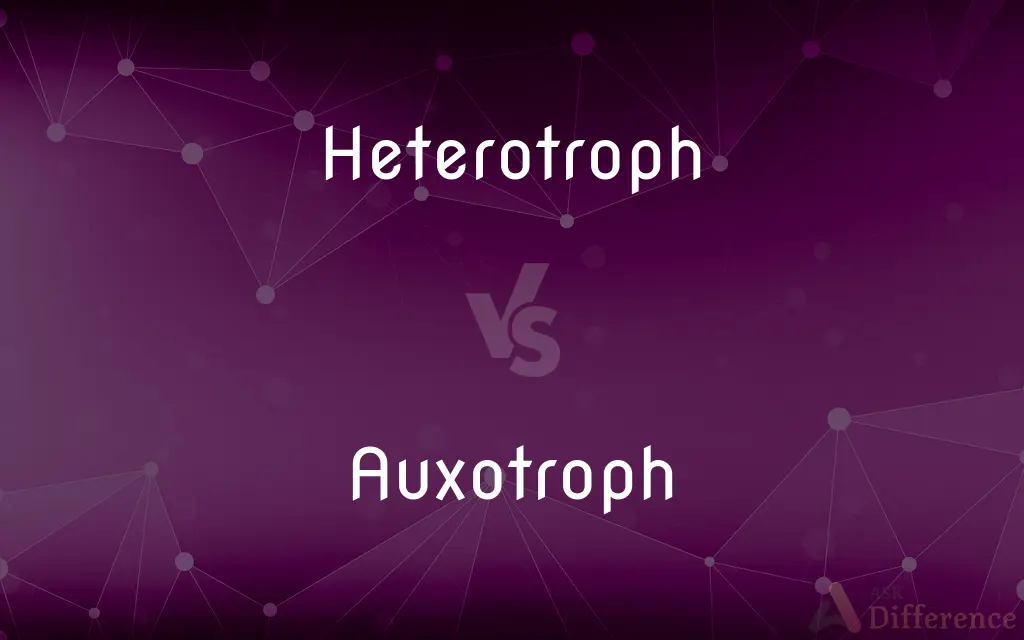Heterotroph vs. Auxotroph — What's the Difference?
By Fiza Rafique & Maham Liaqat — Updated on March 31, 2024
A heterotroph obtains organic carbon for growth, whereas an auxotroph lacks the ability to synthesize a specific organic compound required for its growth.

Difference Between Heterotroph and Auxotroph
Table of Contents
ADVERTISEMENT
Key Differences
Heterotrophs are organisms that cannot produce their own food and rely on organic substances for nutrition, typically consuming other organisms or their byproducts. This contrasts with auxotrophs, which are a specific type of organism (often a mutant strain) that has lost the ability to synthesize a particular compound necessary for its growth, necessitating the addition of this compound to their diet.
Heterotrophs include animals, fungi, and many bacteria that must consume organic material to obtain carbon, the basic building block of life. Whereas, auxotrophs, originally capable of synthesizing all their required compounds, mutate to require supplementary substances they cannot synthesize, often used in laboratory research for genetic studies.
The concept of heterotrophy is broad, applying to all organisms that depend on others for nutrition, while auxotrophy is a specific condition affecting mainly microorganisms, highlighting a genetic deficiency in biosynthetic pathways for essential nutrients.
Heterotrophs are categorized based on their source of carbon as either photoheterotrophs, using light for energy but organic compounds for carbon, or chemoheterotrophs, deriving both energy and carbon from organic substances. On the other hand, auxotrophs are identified based on the specific compound they cannot synthesize, such as amino acid or vitamin auxotrophs, indicating a precise genetic or metabolic limitation.
The distinction between heterotrophs and auxotrophs underscores the variety of nutritional strategies among organisms, with heterotrophs representing a fundamental dietary strategy and auxotrophs reflecting genetic variations that alter nutritional requirements.
ADVERTISEMENT
Comparison Chart
Definition
Organisms that cannot synthesize their own food and rely on organic substances.
Organisms that cannot synthesize a specific compound needed for growth.
Nutritional Source
Organic compounds from other organisms.
Requires specific substances it cannot synthesize.
Organism Type
Animals, fungi, many bacteria.
Typically microorganisms (e.g., bacteria, yeast).
Application
Broad biological concept.
Used in genetic and biochemical research.
Example
A lion eating a zebra.
A yeast strain needing histidine added to its growth medium.
Compare with Definitions
Heterotroph
An organism deriving its nutritional requirements from complex organic substances.
A cow grazing on grass is a heterotroph.
Auxotroph
Represents a conditional phenotype that depends on the external supply of a specific nutrient.
An auxotroph for arginine will grow normally only when arginine is present in the medium.
Heterotroph
Consumers in an ecosystem that feed on other organisms or organic waste.
Mushrooms breaking down a dead tree absorb nutrients as heterotrophs.
Auxotroph
May arise from a single gene mutation affecting an enzyme in a metabolic pathway.
A bacterial auxotroph might lack the ability to synthesize tryptophan due to a genetic mutation.
Heterotroph
Unable to produce organic compounds from inorganic sources.
Humans eat plants and animals because they are heterotrophs.
Auxotroph
Essential in biotechnological applications, including the production of vitamins and amino acids.
Auxotrophic strains of bacteria are engineered to study and optimize the synthesis of essential nutrients.
Heterotroph
Relies on autotrophs directly or indirectly for food.
A rabbit eats plants, relying on their autotrophic ability to synthesize organic compounds.
Auxotroph
A mutant organism that requires a particular substance for its growth that the wild type can synthesize.
An Escherichia coli strain that cannot synthesize leucine is a leucine auxotroph.
Heterotroph
Classified based on their dietary habits, such as herbivores, carnivores, and omnivores.
Bears, as omnivores, are heterotrophs that eat both plants and other animals.
Auxotroph
Used in laboratory studies for genetic mapping and mutation research.
Auxotrophs of yeast are commonly used in genetic studies to understand metabolic pathways.
Heterotroph
A heterotroph (; from Ancient Greek ἕτερος héteros "other" and τροφή trophḗ "nutrition") is an organism that cannot produce its own food, instead taking nutrition from other sources of organic carbon, mainly plant or animal matter. In the food chain, heterotrophs are primary, secondary and tertiary consumers, but not producers.
Auxotroph
A mutant organism (especially a bacterium or fungus) that requires a particular additional nutrient which the normal strain does not.
Heterotroph
An organism that is dependent on complex organic substances for nutrition because it cannot synthesize its own food.
Auxotroph
An organism, such as a strain of bacteria, that has lost the ability to synthesize certain substances required for its growth and metabolism as the result of mutational changes.
Heterotroph
(ecology) An organism which requires an external supply of energy in the form of food as it cannot synthesize its own.
Auxotroph
Any microorganism that has lost the ability to synthesize an organic compound required for its growth, usually as a result of mutation
Heterotroph
An organism that depends on complex organic substances for nutrition
Common Curiosities
Why are auxotrophs important in research?
Auxotrophs are important in research for studying genetic mutations, metabolic pathways, and in biotechnological applications like vitamin synthesis.
What is an auxotroph?
An auxotroph is a microorganism that has lost the ability to synthesize a specific compound necessary for its growth, requiring this compound to be supplied externally.
Can plants be considered heterotrophs?
Most plants are autotrophs, capable of photosynthesis, but some parasitic or carnivorous plants have heterotrophic behavior.
Are humans heterotrophs or autotrophs?
Humans are heterotrophs because they cannot synthesize their own food and must consume plants, animals, or other organic substances.
How do heterotrophs obtain their food?
Heterotrophs obtain their food by consuming other organisms or their organic byproducts.
What is the difference between a photoheterotroph and a chemoheterotroph?
Photoheterotrophs use light for energy but require organic compounds for carbon, whereas chemoheterotrophs obtain both energy and carbon from organic substances.
What is an example of a heterotrophic organism?
An example is a wolf, which relies on other animals for food.
Can a heterotroph be an auxotroph?
While all auxotrophs are heterotrophs by definition, not all heterotrophs are auxotrophs. Auxotrophy is a specific condition related to the inability to synthesize a certain compound.
What is a heterotroph?
A heterotroph is an organism that cannot synthesize its own food and relies on organic compounds produced by other organisms for nutrition.
How do auxotrophs survive in the wild?
Auxotrophs can survive in environments where the missing nutrient is available, or they may not survive outside controlled environments like laboratories.
What is an example of an auxotrophic organism?
An example is a bacterium that requires an external supply of a vitamin it cannot synthesize.
What role do heterotrophs play in the ecosystem?
Heterotrophs play a crucial role in ecosystems as consumers, decomposers, and part of the food web, recycling organic matter and nutrients.
What causes auxotrophy in organisms?
Auxotrophy is usually caused by genetic mutations that affect an organism's metabolic pathways, preventing the synthesis of a specific nutrient.
How does auxotrophy affect an organism's survival?
Auxotrophy can limit an organism's survival to environments where the required nutrient is available or depend on laboratory conditions for growth.
Can auxotrophy be reversed?
In some cases, genetic engineering can reverse auxotrophy by introducing a functional gene that restores the ability to synthesize the needed compound.
Share Your Discovery

Previous Comparison
Herstory vs. History
Next Comparison
Retreat vs. FleeAuthor Spotlight
Written by
Fiza RafiqueFiza Rafique is a skilled content writer at AskDifference.com, where she meticulously refines and enhances written pieces. Drawing from her vast editorial expertise, Fiza ensures clarity, accuracy, and precision in every article. Passionate about language, she continually seeks to elevate the quality of content for readers worldwide.
Co-written by
Maham Liaqat














































